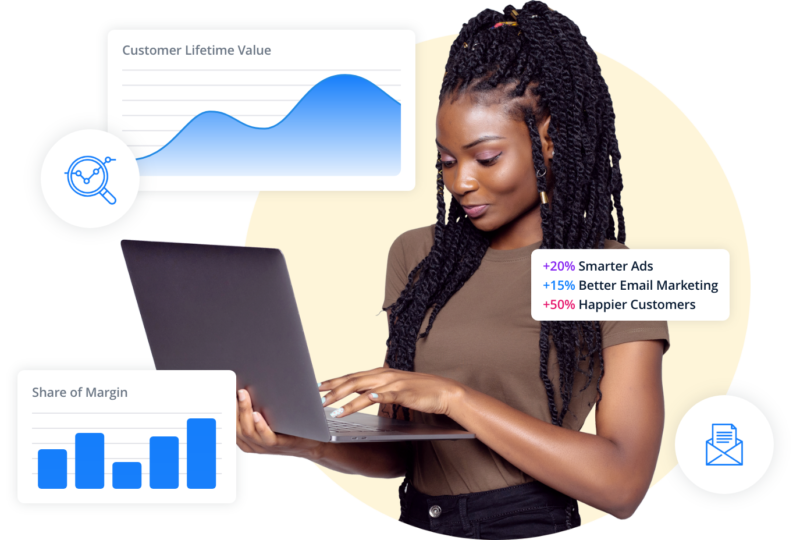- How to Build an Unstoppable Ecommerce Brand
- Step 1: Learn what today’s consumer expects from brands
- Step 2: Listen harder
- Step 3: Establish your style
- Step 4: Build trust with your customers
- Step 5: Learn how quality is important in more than just your product
- Step 6: Be omnipresent
- Step 7: Get organized
- Conclusion
- Learn more
How to Build an Unstoppable Ecommerce Brand
Learn what eCommerce brands need in 2021 and how yours can stand out in this new hyper-competitive environment.

The world of ecommerce moves fast in all directions. New brands penetrate competitive industries and make waves overnight. Products go viral as often as memes. Consumers shift with ease from one shopping interface to another, hardly distinguishing between the opportunities to click “buy” from the content that drives them there.
Unstoppable brands build momentum just as fast, which has come to require a level of agility never seen before. The 2020 pandemic accelerated existing trends, which then positioned winning brands to have an even faster impact. They just had to show up with the right assets.
In this seamless and multichannel world where shoppers are consuming content at rates50% higher than in 2019, the most important asset for a strong presence across every point of contact is your brand.
A strong brand creates an emotional connection with buyers. It has “personality” and is easily recognized. Through product visuals, company messaging and more, your brand tells consumers what your ecommerce business is about.
2021 is a big year for ecommerce as we ride in on the heels of worldwide lockdowns, with the Covid-19 pandemic havingaccelerated the growth of online shopping by four to six years. Greater adoption and demand of ecommerce does mean more opportunity, but it also means stiffer competition, and growing sales in this environment means building an ecommerce brand.
Here are the steps to do just that.
What you’ll learn in this article
Buckle up because you’re about to learn how an unstoppable brand is defined in 2021—and how you can build one. We’ll take you on a proven step-by-step process where you:
- Learn what today’s consumers expect
- Listen harder
- Establish your brand style
- Build trust
- Make every step of your journey sing “quality”
- Be omnipresent
-
Prerequisites (what you need to know)
Be sure you come into this topic with an idea ofwhat’s changed in the ecommerce customer experience as well ashow to build a solid value proposition.
Step 1: Learn what today’s consumer expects from brands
Brands have taken up a new role in consumers’ lives. With direct-to-consumer (D2C) sales on the rise (and55% of consumers preferring to buy directly from manufacturers), consumers have benefited in big ways from direct interaction with the brands they like and trust. By cutting out the middleman (i.e. retailers), they pay less and buying friction is reduced. Brands, similarly, benefit from creating direct and more meaningful relationships with customers for a greater customer value optimization (CVO) over time.

Optimize your Customer Lifetime Value strategy
Get more valuable customers for a more profitable e-store.
60+ reviews on Shopify
__5/5
Available for all platforms:

Discover all features
Consumers have also been drawn to D2C through the content they consume, especially after a year of lockdowns with little else to do than play with our phones. Product videos are the new norm, and the most innovative ones don’t even feel like marketing. Consumers tap from one channel to another on the waves of a brand’s buyer journey without even realizing it. Whole content funnels built with blogs, enriched photos, comprehensive guides, “how-to” material and augmented reality (AR)-powered experiences take consumers on a more in-depth ride than they ever had in stores.
The combination of competition and demand in the D2C market has turbo-charged a new buyer journey. In spite of the physical experience with a product being made impossible when buying online, the additional information available about a brand and its products has overshadowed the brick-and-mortar experience.
What does this mean for brands? It means your brand identity is even more important and it can be achievable with the help of a creative brand identity designer. To connect with consumers, your brand is your voice and the face of every interaction. We didn’t title this article “How to Build an Unstoppable Ecommerce Company” because we’re not writing about operational efficiencies or backend strategies. We’re writing about the brand that makes the essential connection with consumers, because it’s your brand they buy from, not your back office.
Consumers want to connect with you as demonstrated by the huge adoption of D2C. Understand that, and you’ll be ready to manage how your brand is represented online.Step 2: Listen harder
The idea of “social listening” is traditionally defined as watching for any mention of your brand online. This is important to do because if someone is saying something (good or bad), you want to know. The feedback is invaluable, and the public forum gives you an opportunity to respond and show what your brand is all about.
To create an unstoppable brand, however, you have to listen harder.
To build real momentum for your brand, take your social listening and add to it mentions of any brands you compete with. On top of that, listen for mentions of any brands you like or want to imitate. Finally, listen to consumers talking about the specific products you offer (or the pain points your products solve). This will clue you into what they want from you.
For example, if you sell online wool sweaters, set up a Google alert for “wool sweaters” and other related search strings. If you start to see multiple alerts come in from consumer posts seeking “clever ways to clean wool sweaters,” “how to clean wool sweaters” or social statuses bemoaning “I wish I knew how to clean wool sweaters,” there’s a clear opportunity for you. Perhaps you should partner with a manufacturer of wool-specific cleaning products, or even make your own. Maybe you already do, and you know now to create more content like “how-tos” and detailed care guides for your sweater line.
Social listening will give you fundamental insights into what your brand should say because you’ll have an ear to what consumers want. This is the fuel to spark a powerful brand engine.Step 3: Establish your style
Once you’ve identified what consumers want (and, specifically, what your customers want), you’re ready to establish your brand style. Get hip on this style sense because it’s not just about adopting what’s _chic. _Brand style is about taking your brand purpose and crafting it into a memorable personality of sorts.
Consumers today appreciate authenticity in a big way. It’s one of the reasons why D2C sales have become so popular. To meet that expectation, your brand style should reflect the very focus of your brand. For instance, if you sell electrolyte-enhanced water and aim to support recreational athletes’ active lifestyle, your brand style will probably be defined as energizing, happy, and even competitive. It might be a little sweaty, too, but in that heart-pounding way your audience loves!
Your brand style is simply the union of the elements that communicate your brand personality.
To identify your style, start by articulating your values. Are you an earthy brand that favors processes geared at protecting the environment? Are you an innovative brand that uses your customer base as a perpetual beta group for your groundbreaking electronics? Write your values down, whatever they are.
Next, take your values and work with your marketing team to decide on the “style” elements that will best portray them. Those elements include: Your logo
- Your brand colors
- Your fonts and font size relationship
- Your iconography rules
Once you have your style defined, it’s time to rev that engine and build momentum with consumers themselves.
Step 4: Build trust with your customers
Consumer trust is a must-have for any brand. In ecommerce, it’s even more important. Online shoppers have an easy time navigating away from your page, after all, so any inkling that they can’t trust you is enough for them to leave and forget you forever.
Fortunately, your brand personality can help you build trust.
One of the best ways to build trust with consumers today is by creating buzz. If online users are talking in a positive way about your brand and interacting with your content, that builds trust in the eyes of other users. In order to score that kind of interaction, create industry-specific content that hits the interests and pain points of your target audience. As long as all the content you create is consistent with your brand style, it will start building your forward momentum toward an unstoppable brand.
To get started generating buzz for your brand, you can:
- Create blog posts on topics you really care about. Let your passion show and make your values clear. Consumers will pick up on this level of authenticity.
- Participate in online forums related to your industry. Everywhere from Quora to Facebook and Reddit, users are talking about things where you can easily and organically jump into the conversation.
- Find your industry’s influencers and reach out to them. Who in your industry (or in your target audience) do consumers look up to? Influencers who already speak to your values in their own content can genuinely promote your brand to their followers.
If you aren’t already creating consistently-branded content, start an ecommerce business today. Write down at least a dozen questions your customers regularly ask, and turn each into a blog article. Take your social listening notes and look for clues to what other needs aren’t being scratched. Then, take your knowledge and experience to create funnels of content that manifest your brand in every consumable way.
Step 5: Learn how quality is important in more than just your product
The up-and-coming ecommerce brands today that have gotten the most attention are often the ones selling a single product (instead of many).
Why?
Consumers have an easier time becoming loyal to a product they know they can rely on. This isn’t a new phenomenon. What is new, however, is that the perception of a “product you can rely on” is no longer about the product itself, but the whole buying experience.
All over the world, consumers were forced to buy products online that they had spent a lifetime buying in stores. Those who had been holding out on ecommerce had to finally adopt. With massive store closures and worldwide quarantines, in most cases spanning months at a time, knowing what brands provided reliable delivery and customer service became just as important as the quality of the products themselves.
To keep your brand messaging consistent past those initial touchpoints with prospective buyers, your whole buyer journey has to sing “quality.” Ask:
- What are your customers’ interactions like with your brand on messaging channels?
- How are consumer interactions with your website’s chatbot?
- How do your product listings sing “quality” when users finally land there?
- And is your order fulfillment on the same level as your brand and content?
For a brand to deliver on end-to-end quality, every customer interaction has to be frictionless. Your non-promotional content will be at the top of that experience, withuser experience (UX)-optimized product listings coming after that. Customer service practices will come next, and then (of course) the quality of the product you deliver.
Get your whole buyer journey maximized for quality, and your brand will be one strategy away from unstoppable.
Step 6: Be omnipresent
We’ve talked about the seamless buyer experience as consumers tap from one channel to the next. The perception on their end is of a constant flow (with no reason to “shut the valve off”). For a brand to offer this kind of experience, it must be everywhere (i.e., omnipresent).
Your growing library of branded content will be a good start to make your brand omnipresent: you have your blog up and running while your social posts churn impressions and your Amazon ads hum away. Above all else, however, for that omnipresent advantage, your products must be available for purchase on multiple channels because today’s consumer is buying everywhere, including:
- Marketplaces like Amazon or Walmat.com
- Social media marketplaces
- Comparison shopping engines
- Ecommerce website storefronts
- Affiliate content
- Shoppable emails
A truly unstoppable brand will decidewhich marketplaces to sell on as well as what new channels to leverage. You can learn which channels make the most sense for your brand based on your brand’s values and where your buyers “hang out.”
Step 7: Get organized
Social media growth isoutpacing global population growth by nine to one, and ecommerce taking place directly on social platforms has taken the world by storm. After all, social channels were designed to feature engaging content.
More than ever, product content is now the name of the game.
With the new buyer experience (and trends like product listings with AR-powered tools, enriched photos and massive content marketing funnels), each product you make now will require a whole library of assets behind it. Add to that the fact that each product listing on every channel will require specific optimizations in its product data (descriptions, bullet-points, SKUs, etc.), and you’re looking at an overlapping labyrinth of product information that would be impossible to manage.
One tool can change that.
An unstoppable brand can only move forward with a clear path to its destination. To be omnipresent with an authentic and memorable brand, your content and product data needs to be organized with your bigger brand strategy. A product information management software (PIM) is the tool designed to do just that. Aggregate all your product data easily, then optimize it for every channel, still keeping all your enriched product content organized with it.
Conclusion
An unstoppable brand will fly straight into the horizon of a bright future if the route is set right. Assess your own brand strategy step-by-step so you can identify what your audience wants, speak clearly to it, and then build the trust that will bring lasting relationships. Make your brand as recognizable as it is omnipresent. Above all else, be strategic and stay organized, or all your work will be for naught!

Become a Master of Retention!
Know, predict & accelerate your customers’ moves!
60+ reviews on Shopify
__5/5
Available for all platforms:
Learn more
Now that you’ve figured out what 2020 means for consumer expectations from your brand (and how you’re going to leverage that), keep reading to learn:
- More abouthow ecommerce brands can prosper in 2021
- More aboutcustomer retention
- And more aboutthe future of ecommerce


